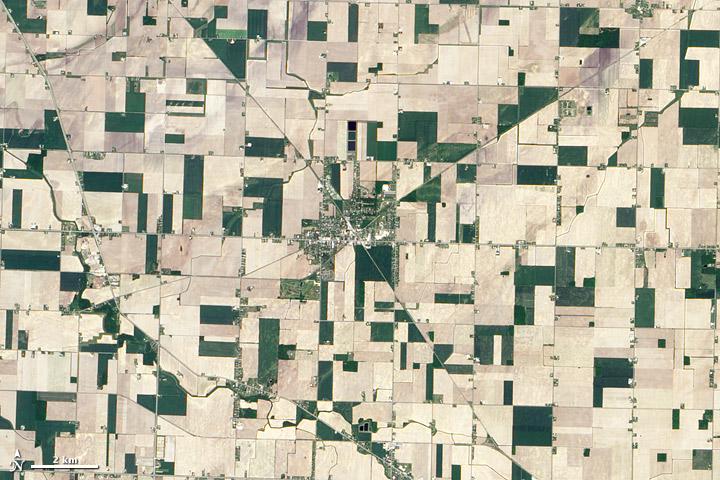acquired May 21, 2012
download large image (1 MB, JPEG, 2465x1644)
acquired May 21, 2012
download GeoTIFF file (7 MB, TIFF)
acquired May 21, 2012
download Google Earth file (KML)
The small town of Reese, Michigan, is
a cluster of white and green around the crossroads of two railroads and
a highway in this true-color image. Acquired by the Advanced Land
Imager (ALI) on NASA’s Earth Observing-1 (EO-1) satellite, the image shows the town on May 21, 2012.
The patterns on display can be traced back to an act of the
Continental Congress. The new nation was expanding and trying to decide
how to manage and govern newly settled lands west of the Appalachian
Mountains. In the Ordinance of 1785, the young government divided the
land into townships of six square miles; townships were subdivided into
individual plots measuring one square mile (640 acres) apiece. The act
divided western lands into squares and laid the foundation for the Homestead Act of 1865, in which public lands were transferred to private citizens who lived on the land.
The remnants of those square property boundaries are evident in the
regular shape of the fields surrounding Reese. Since homesteaders had to
live on their property, small supply centers sprung up around
crossroads. Later, towns developed along railroads, since trains needed
to be resupplied with water every eight to ten miles. These supply stops
provided way points and hubs for mail delivery and for the storage of
farm products (grain, livestock) for shipping to larger markets, stores,
schools, and churches.
Reese seems to have been settled for all of these reasons. The town
was established in 1873 along a new road connecting Saginaw in the west
and Watrousville in the east. The road is the straight line along the
lower edge of the town. The railroad also came to the area in 1873, and
G.W. Reese was the railroad superintendent. The town became known as
Reese and expanded around the railroad, now sitting in the center of the
”X“ formed by the railroad lines.
Reese is like a thousand other small towns found along transportation lines
in the United States. As transportation became more efficient, small
towns faded and services were consolidated in larger cities. In 2010,
Reese had a population of 1,454, while nearby Saginaw reached a population of 51,508.
References
- Reese, Michigan History of Reese. Accessed December 19, 2013.
- United States Census Bureau (2013, June 27) Saginaw (city), Michigan. Accessed December 19, 2013.
- University of Nebraska-Lincoln (2011) Encyclopedia of the Great Plains. Accessed December 19, 2013.
NASA image by Jesse Allen and Robert Simmon using ALI data from the NASA EO-1 team. Caption by Holli Riebeek.
- Instrument:
- EO-1 - ALI
NASA: USA - Michigan - Reese - 01.05.13
Ricardo M Marcenaro - Facebook
Blogs in operation of The Solitary Dog:
Solitary Dog Sculptor:
http://byricardomarcenaro.blogspot.com
Solitary Dog Sculptor I:
http://byricardomarcenaroi.blogspot.com
Para:
comunicarse conmigo,
enviar materiales para publicar,
propuestas comerciales:
marcenaroescultor@gmail.com
For:
contact me,
submit materials for publication,
commercial proposals:
marcenaroescultor@gmail.com
My blogs are an open house to all cultures, religions and countries. Be a
follower if you like it, with this action you are building a new
culture of tolerance, open mind and heart for peace, love and human
respect.
Thanks :)
Mis blogs son una casa abierta a todas las culturas, religiones y
países. Se un seguidor si quieres, con esta acción usted está
construyendo una nueva cultura de la tolerancia, la mente y el corazón
abiertos para la paz, el amor y el respeto humano.
Gracias :)


















